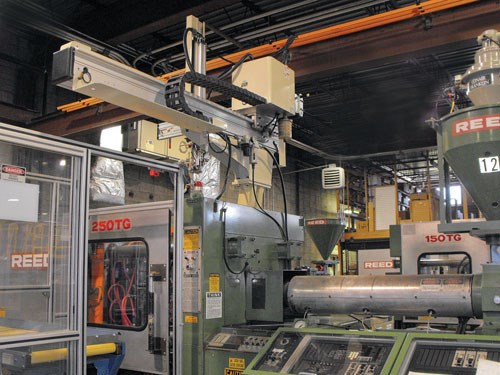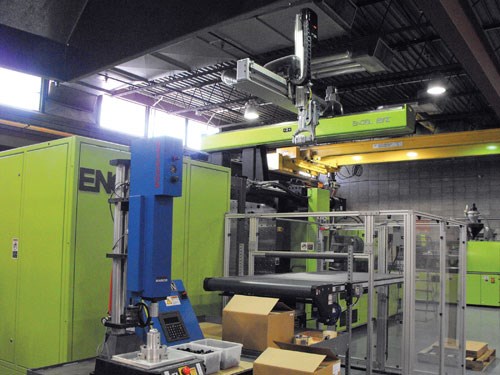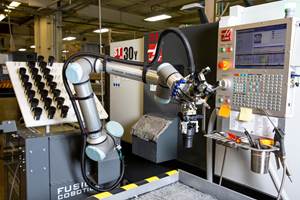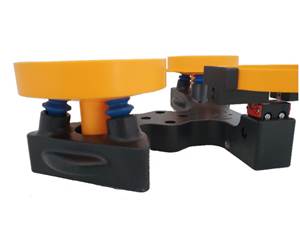Automation, Old-Fashioned Values Help Sustain Molder’s Success
This 55-year-old, family-owned and operated custom injection molding company continues to thrive by practicing a value that’s gained widespread popularity lately: “sustainability.”
A 55-year-old, family-owned and operated custom injection molding company—founded by a man who ran the very first American-built
injection molding machine in 1936—continues to thrive by practicing a value that’s gained widespread popularity lately: “sustainability.”
“I guess it’s a relatively recent buzzword, but sustainability is a word that best describes how our business has been run since its inception,” says Anthony Miragliotta, Jr., president of Mira Plastics in Newton, N.J. (miraplastics.com), and son of the company’s founder, the late Anthony Miragliotta, Sr.
“I can recall, for instance, when there was a lot of news about molders recycling cold runners—we were doing that 50 years ago here, but that was discontinued when we began designing tools with hot manifolds and runners. Though our scrap rate is nearly zero today, we use a local recycler when necessary—not a landfill.”
“It’s like that all over our operations. Nothing’s just thrown out,” adds Anthony Peter Miragliotta, v.p. and Anthony Jr.s son.
“We probably produce less trash than a household,” jokes Tina Miragliotta, Anthony Jr.’s daughter and company treasurer. “It’s always been that way for us. The majority of tooling out in the shop produces zero scrap… absolutely none.”
“I guess what we really mean by sustainability is paying the bills on time,” Anthony Jr. adds. “That’s a practice we’ve sustained throughout our existence. Sure, that ‘rainy day’ is here, but we still always pay our bills on time.
“I also believe sustainability goes together with Lean Manufacturing. We were ‘Lean’ before they came up with the term. And we sustain good relationships with our vendors and with our customers. Our vendors want us to succeed.
“Plus, we’re a closely knit family. That’s sustainability, too. We only take on jobs we all agree we can handle."
RELIABLE RESOURCES
At its 62,000-ft² plant, Mira Plastics molds 4 million to 5 million parts a year for assorted industrial and commercial markets—including electrical/electronics, cosmetics, housewares, toys, hobbies, point-of-purchase products, HVAC, educational, and promotional items—for customers ranging from “mom-and-pop” shops to Fortune 500 companies.
Employing about two dozen, including some who have been with the company more than that number of years, Mira Plastics runs 24/5, consuming 3 million to 4 million lb/yr of filled and unfilled materials, including polyolefins, styrenics, acrylic, polycarbonate, and TP elastomers, plus special conductive and ESD compounds. Capital investment is $8 million and annual sales average $3 million to $5 million.
Its air-conditioned manufacturing area, well lit by metal halide lighting from an 18-ft-high ceiling, has epoxy flooring 3/8-in.-thick and coated with acrylic wax, which is annually stripped and replaced. The company runs 18 U.S.-built Engel, HPM, and Reed-Prentice hydraulic toggle molding machines, ranging from 60 to 1250 tons. Half of them are Reeds.
Why stick with a bygone brand? “Reliability,” answers Anthony Peter. “We’ve had no issues with our Reeds. We can go home at night, go to bed, and come back in the morning knowing they’re running. Both the machinery mechanics and control systems were highly sophisticated—a good 20 years ahead of their next closest competitors when they stopped building machines. My grandfather bought the first Reed off the line.” (It had a 2-oz shot capacity.)
“We’ve found that operating an Engel is as easy as operating a Reed,” Anthony Jr. adds. “We bought a small tiebarless Engel in 2007. It’s smooth-running, consistent, accurate, and quiet. And it’s easy to set up and run larger molds, providing the shot size is capable. Engel provides good technical support, too, though we haven’t really needed to contact its service department after start-ups.”
What, no all-electrics?
“We’d love to use all-electrics, if for no other reason than to do away with any oil leakage,” Anthony Peter admits. “But the majority of the parts we’re molding are on the longer-cycle side of things, and often have heavy wall sections. From what we’ve learned, we’re not going to gain any appreciable energy savings running such parts on an all-electric. Also, we’d see greater wear on the drives, because of the long pack times for such parts.”
AUTOMATION ADVOCATES
“Since 1955, automation has been and continues to be the key to sustaining our success,” says Anthony Jr. “We think we’re as lean as we can possibly get. There’s no ‘dead wood’ in our plant.”
Mira Plastics has used Yushin robots since 1998. All it’s had to replace on them are suction cups. The robots’ controls were integrated into the company’s Reed PM machine controllers in-house, according to Anthony Jr. “Luckily, my father acquired Reed’s controller wiring diagrams before they stopped building presses,” he says. Engel robots arrived more recently. “Automated molding has given us better production rates and better parts without additional costs. Robots also eliminate operator fatigue from opening and closing gates, which can adversely affect product quality.”
“If you keep the process set, you should get perfect parts. That’s sustainability—that’s how you compete,” Anthony Peter adds. “On one job, we ran 1.5 million parts without a single reject or return, and we secured that job for an additional two years.”
“Articles I’ve read on automation usually involve robotics, but there’s more to it than just robotics,” says Tina. “For instance, from our earliest days, we’ve been running automatic cycles rather than single cycles.”
Almost all of Mira Plastics’ 200 active molds are runnerless. Molds are sourced domestically. “We make our money here and we spend it here,” says Tina.
SERVICEABLE SECONDARIES
A job came in about a year ago that spun Mira Plastics into a technology new to the company. The involved a four-part assembly and two inserts, all of which had to mate. It was a cosmetics application with a 0.030- to 0.040-in. wall that was developed to contain a liquid. The mating issue was solved with the first batch of parts run off of the four molds, thanks to the company’s expertise in interpreting specifications and its working knowledge of running the materials required. However, the assembly issue posed more of a challenge.
“Those components were designed for a press fit. Part samples out in the field had leakage issues, but the materials chosen for the application didn’t lend themselves to ultrasonic welding,” Anthony Jr. explains. The company met the challenge with a spin welder it purchased from Branson Ultrasonics.
Mira also uses hot stamping, ultrasonic welding, and insert staking when necessary. The firm can apply heat-transfer decals to parts, and it performs both light assembly and packaging.
Crizaf conveyors, Sterlco hot-water temperature controls, and Athena hot-runner controllers are company standards. It also has standardized on machine-mounted Conair vacuum hopper loaders and color blenders. Conair dehumidifying dryers are wheeled out to molding stations when they’re needed.
Off the shop floor is the company’s expansive warehouse area. It comprises three 12,000-ft² rooms. “A lot of our customers like to have immediate availability to their products,” says Tina.
“It’s our version of just-in-time,” adds Anthony Peter. “We turn our inventory over at least twice a month.”
“I got a call this morning from a customer who had just returned from his vacation and was out of parts,” Tina continues. “If we didn’t have them already molded—more than 60,000 pieces—we couldn’t ship them out ‘just-in-time.’”
SUSTAINING SUCCESS
“Over the years, I’ll bet that more than 50% of the jobs we’ve run had originally been run elsewhere—they came from customers who had quality and manufacturing issues with other suppliers,” says Tina. “We’ve grown our business throught such projects quite a bit."
Although Mira Plastics operates under industry-standard and customer-specific quality programs, last month it was awaiting ISO 9001:2008 certification through a New Jersey state manufacturing extension program. “We’re hoping ISO certification will open-up new markets to us, such as military and medical,” says Tina.
Another recent move was the company’s first participation as an exhibitor at a trade show last September—the “Design 2 Part” expo sponsored by The Job Shop Company Inc., Prospect, Conn. “It’s a real challenge, trying to talk about yourself in public, being personable, emphasizing our customer service and the attention we give to a job,” Anthony Jr. admits.
“We weren’t there showing any new technology,” adds Anthony Peter. “We were just there to exhibit who we are and what we’re all about.”
“Still, a representative of a company met Anthony at that show, and wound up transferring eight tools here, because they were unsatisfied with their molder. We were very happy with that,” Tina says.
What’s in store for Mira Plastics over the next half-century? Anthony Jr. says, “We’re quite content to sustain our status as custom injection molders.”
Related Content
Smart Granulator Control Integrates Size-Reduction Systems, Enables Predictive and Knife Maintenance
NPE 2024: Conair’s New SG Control is available for its Viper Granulators
Read MoreFour Industry 4.0 Tech Adoption Insights from Indiana Plastics Manufacturers
As more plastics manufacturers step into the Fourth Industrial Revolution, insights have emerged about how best to approach the digital transformation journey.
Read MoreEnsuring Repeatability: The Key to Effective Injection Molding Automation
One of automation’s key promises is repeatability: the same movement to the same location, time and time again. But to achieve that, all elements involved — robot, machine, EOAT, mold — must be in and stay in alignment.
Read MoreMold Monitor Adds Wireless Connectivity
NPE2024: Progressive’s CVe OnDemand software now offers wireless connectivity.
Read MoreRead Next
Making the Circular Economy a Reality
Driven by brand owner demands and new worldwide legislation, the entire supply chain is working toward the shift to circularity, with some evidence the circular economy has already begun.
Read MoreFor PLASTICS' CEO Seaholm, NPE to Shine Light on Sustainability Successes
With advocacy, communication and sustainability as three main pillars, Seaholm leads a trade association to NPE that ‘is more active today than we have ever been.’
Read MoreBeyond Prototypes: 8 Ways the Plastics Industry Is Using 3D Printing
Plastics processors are finding applications for 3D printing around the plant and across the supply chain. Here are 8 examples to look for at NPE2024.
Read More

















